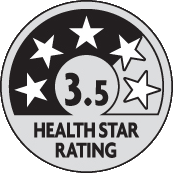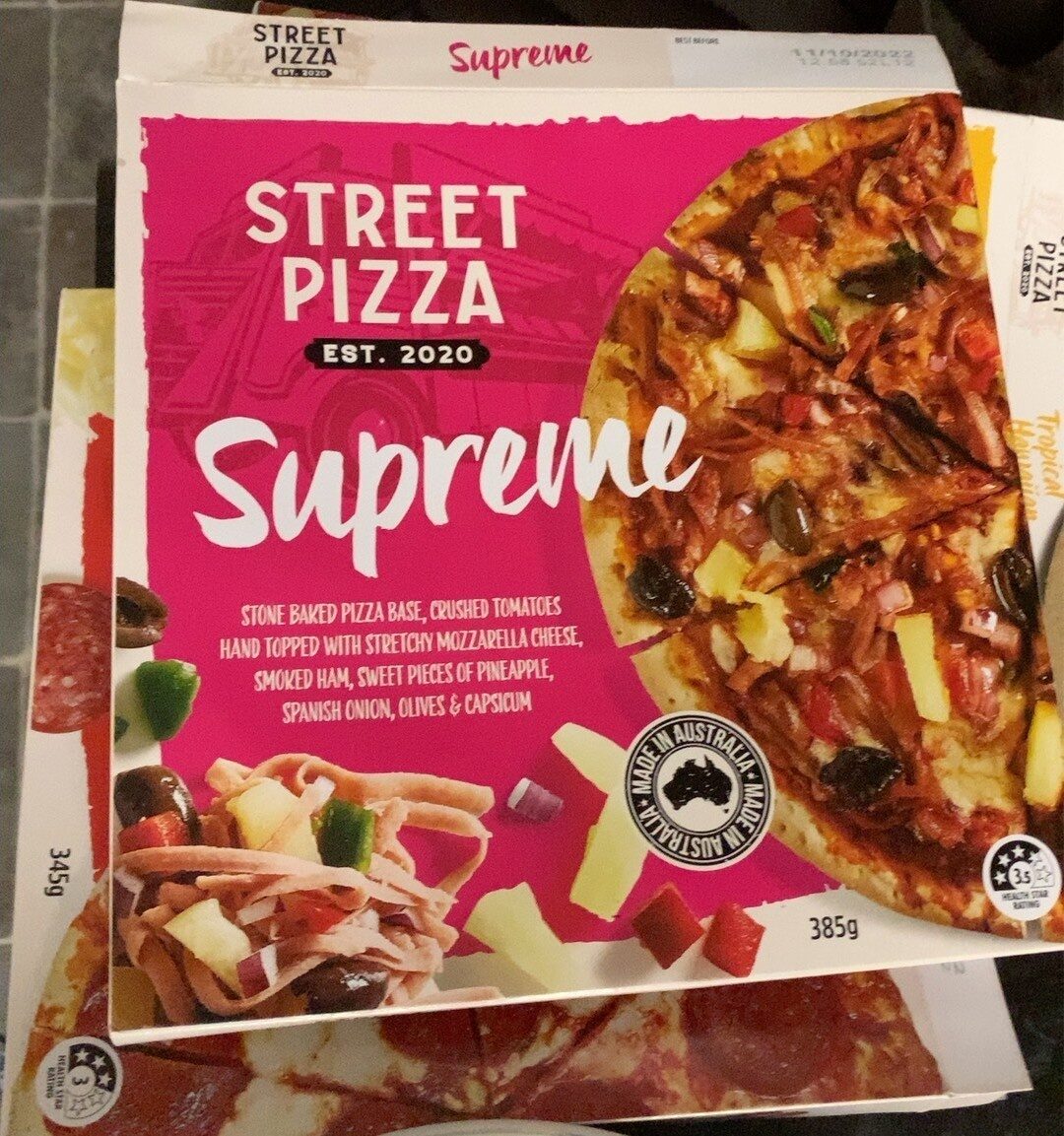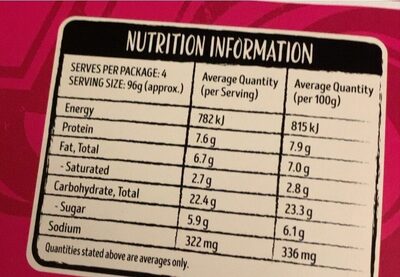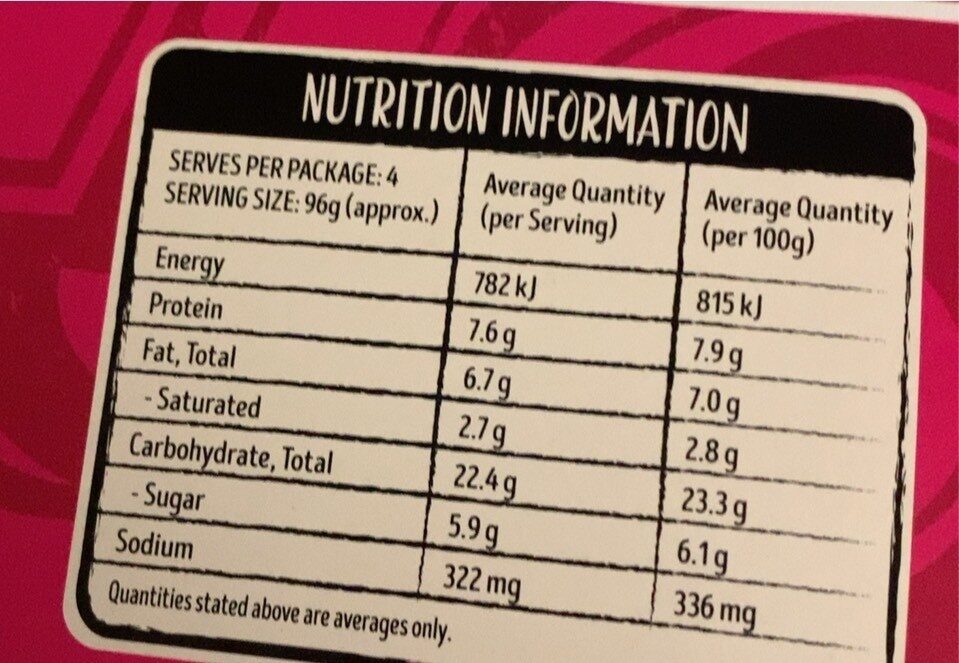Help us make food transparency the norm!
As a non-profit organization, we depend on your donations to continue informing consumers around the world about what they eat.
The food revolution starts with you!
Supreme pizza - Street Pizza - 385g
Supreme pizza - Street Pizza - 385g
This product page is not complete. You can help to complete it by editing it and adding more data from the photos we have, or by taking more photos using the app for Android or iPhone/iPad. Thank you!
×
Barcode: 9338033006098 (EAN / EAN-13)
Quantity: 385g
Brands: Street Pizza
Categories: Frozen foods, Meals, Pizzas pies and quiches, Pizzas, Frozen pizzas and pies, Frozen pizzas
Labels, certifications, awards:
Health Star Rating, Health Star Rating 3.5
Origin of ingredients: Australia
Manufacturing or processing places: Australia
Stores: Coles
Countries where sold: Australia
Matching with your preferences
Health
Ingredients
-
58 ingredients
Pizza Base (Australian Flour (Wheat Flour, Thiamine, Folic Acid), Water, Canola Oil, Salt, Sugar, Yeast), Tomato Passata[Tomatoes, Sugar, Salt, Garlic Powder, Oregano], Mozzarella Cheese [Cheese (Pasteurised Milk, Milk Solids, Salt, Acidity Regulator (270), Coagulating Enzyme)], Shredded Ham[Meat (63%), Water, Food Starch (Potato, Tapioca, Maize), Salt, Food Acid (325), Soy Protein, Flavouring, Mineral Salt (451), Sugar, Vegetable Gum (407), Antioxidants (316), Hydrolysed Vegetable Protein, Sodium Nitrite (250), Vegetable Oil, Vegetable Extract], Pineapple, Olive, Red & Green Capsicums, Spanish Onion. CONTAINS GLUTEN (WHEAT), SOY AND MILK. No artificial flavour and colours. WARNING: Although every effort has been made to remove pit and pit fragments some may remain.Allergens: Gluten, Milk, Soybeans
Food processing
-
Ultra processed foods
Elements that indicate the product is in the 4 - Ultra processed food and drink products group:
- Additive: E325 - Sodium lactate
- Additive: E407 - Carrageenan
- Additive: E451 - Triphosphates
- Ingredient: Flavouring
Food products are classified into 4 groups according to their degree of processing:
- Unprocessed or minimally processed foods
- Processed culinary ingredients
- Processed foods
- Ultra processed foods
The determination of the group is based on the category of the product and on the ingredients it contains.
Additives
-
E250 - Sodium nitrite
Sodium nitrite: Sodium nitrite is the inorganic compound with the chemical formula NaNO2. It is a white to slightly yellowish crystalline powder that is very soluble in water and is hygroscopic. It is a useful precursor to a variety of organic compounds, such as pharmaceuticals, dyes, and pesticides, but it is probably best known as a food additive to prevent botulism. It is on the World Health Organization's List of Essential Medicines, the most important medications needed in a basic health system.Nitrate or nitrite -ingested- under conditions that result in endogenous nitrosation has been classified as "probably carcinogenic to humans" by International Agency for Research on Cancer -IARC-.Source: Wikipedia
-
E270 - Lactic acid
Lactic acid: Lactic acid is an organic compound with the formula CH3CH-OH-COOH. In its solid state, it is white and water-soluble. In its liquid state, it is colorless. It is produced both naturally and synthetically. With a hydroxyl group adjacent to the carboxyl group, lactic acid is classified as an alpha-hydroxy acid -AHA-. In the form of its conjugate base called lactate, it plays a role in several biochemical processes. In solution, it can ionize a proton from the carboxyl group, producing the lactate ion CH3CH-OH-CO−2. Compared to acetic acid, its pKa is 1 unit less, meaning lactic acid deprotonates ten times more easily than acetic acid does. This higher acidity is the consequence of the intramolecular hydrogen bonding between the α-hydroxyl and the carboxylate group. Lactic acid is chiral, consisting of two optical isomers. One is known as L--+--lactic acid or -S--lactic acid and the other, its mirror image, is D--−--lactic acid or -R--lactic acid. A mixture of the two in equal amounts is called DL-lactic acid, or racemic lactic acid. Lactic acid is hygroscopic. DL-lactic acid is miscible with water and with ethanol above its melting point which is around 17 or 18 °C. D-lactic acid and L-lactic acid have a higher melting point. In animals, L-lactate is constantly produced from pyruvate via the enzyme lactate dehydrogenase -LDH- in a process of fermentation during normal metabolism and exercise. It does not increase in concentration until the rate of lactate production exceeds the rate of lactate removal, which is governed by a number of factors, including monocarboxylate transporters, concentration and isoform of LDH, and oxidative capacity of tissues. The concentration of blood lactate is usually 1–2 mM at rest, but can rise to over 20 mM during intense exertion and as high as 25 mM afterward. In addition to other biological roles, L-lactic acid is the primary endogenous agonist of hydroxycarboxylic acid receptor 1 -HCA1-, which is a Gi/o-coupled G protein-coupled receptor -GPCR-.In industry, lactic acid fermentation is performed by lactic acid bacteria, which convert simple carbohydrates such as glucose, sucrose, or galactose to lactic acid. These bacteria can also grow in the mouth; the acid they produce is responsible for the tooth decay known as caries. In medicine, lactate is one of the main components of lactated Ringer's solution and Hartmann's solution. These intravenous fluids consist of sodium and potassium cations along with lactate and chloride anions in solution with distilled water, generally in concentrations isotonic with human blood. It is most commonly used for fluid resuscitation after blood loss due to trauma, surgery, or burns.Source: Wikipedia
-
E316 - Sodium erythorbate
Sodium erythorbate: Sodium erythorbate -C6H7NaO6- is a food additive used predominantly in meats, poultry, and soft drinks. Chemically, it is the sodium salt of erythorbic acid. When used in processed meat such as hot dogs and beef sticks, it increases the rate at which nitrite reduces to nitric oxide, thus facilitating a faster cure and retaining the pink coloring. As an antioxidant structurally related to vitamin C, it helps improve flavor stability and prevents the formation of carcinogenic nitrosamines. When used as a food additive, its E number is E316. The use of erythorbic acid and sodium erythorbate as a food preservative has increased greatly since the U.S. Food and Drug Administration banned the use of sulfites as preservatives in foods intended to be eaten fresh -such as ingredients for fresh salads- and as food processors have responded to the fact that some people are allergic to sulfites. It can also be found in bologna, and is occasionally used in beverages, baked goods, and potato salad.Sodium erythorbate is produced from sugars derived from different sources, such as beets, sugar cane, and corn. An urban myth claims that sodium erythorbate is made from ground earthworms; however, there is no truth to the myth. It is thought that the genesis of the legend comes from the similarity of the chemical name to the words earthworm and bait.Alternative applications include the development of additives that could be utilized as anti-oxidants in general. For instance, this substance has been implemented in the development of corrosion inhibitors for metals and it has been implemented in active packaging.Sodium erythorbate is soluble in water. The pH of the aqueous solution of the sodium salt is between 5 and 6. A 10% solution, made from commercial grade sodium erythorbate, may have a pH of 7.2 to 7.9. In its dry, crystalline state it is nonreactive. But, when in solution with water it readily reacts with atmospheric oxygen and other oxidizing agents, which makes it a valuable antioxidant.Source: Wikipedia
-
E325 - Sodium lactate
Sodium lactate: Sodium lactate is the sodium salt of lactic acid, and has a mild saline taste. It is produced by fermentation of a sugar source, such as corn or beets, and then, by neutralizing the resulting lactic acid to create a compound having the formula NaC3H5O3.Source: Wikipedia
-
E407 - Carrageenan
Carrageenan (E407), derived from red seaweed, is widely employed in the food industry as a gelling, thickening, and stabilizing agent, notably in dairy and meat products.
It can exist in various forms, each imparting distinct textural properties to food.
However, its degraded form, often referred to as poligeenan, has raised health concerns due to its potential inflammatory effects and its classification as a possible human carcinogen (Group 2B) by the International Agency for Research on Cancer (IARC).
Nevertheless, food-grade carrageenan has been deemed safe by various regulatory bodies when consumed in amounts typically found in food.
-
E451 - Triphosphates
Sodium triphosphate: Sodium triphosphate -STP-, also sodium tripolyphosphate -STPP-, or tripolyphosphate -TPP-,- is an inorganic compound with formula Na5P3O10. It is the sodium salt of the polyphosphate penta-anion, which is the conjugate base of triphosphoric acid. It is produced on a large scale as a component of many domestic and industrial products, especially detergents. Environmental problems associated with eutrophication are attributed to its widespread use.Source: Wikipedia
Ingredients analysis
-
May contain palm oil
Ingredients that may contain palm oil: Vegetable oil
-
Non-vegan
Non-vegan ingredients: Mozzarella, Cheese, Pasteurised milk, Milk solids, Ham, Meat, MilkSome ingredients could not be recognized.
We need your help!
You can help us recognize more ingredients and better analyze the list of ingredients for this product and others:
- Edit this product page to correct spelling mistakes in the ingredients list, and/or to remove ingredients in other languages and sentences that are not related to the ingredients.
- Add new entries, synonyms or translations to our multilingual lists of ingredients, ingredient processing methods, and labels.
If you would like to help, join the #ingredients channel on our Slack discussion space and/or learn about ingredients analysis on our wiki. Thank you!
-
Non-vegetarian
Non-vegetarian ingredients: Ham, MeatSome ingredients could not be recognized.
We need your help!
You can help us recognize more ingredients and better analyze the list of ingredients for this product and others:
- Edit this product page to correct spelling mistakes in the ingredients list, and/or to remove ingredients in other languages and sentences that are not related to the ingredients.
- Add new entries, synonyms or translations to our multilingual lists of ingredients, ingredient processing methods, and labels.
If you would like to help, join the #ingredients channel on our Slack discussion space and/or learn about ingredients analysis on our wiki. Thank you!
-
Details of the analysis of the ingredients
We need your help!
Some ingredients could not be recognized.
We need your help!
You can help us recognize more ingredients and better analyze the list of ingredients for this product and others:
- Edit this product page to correct spelling mistakes in the ingredients list, and/or to remove ingredients in other languages and sentences that are not related to the ingredients.
- Add new entries, synonyms or translations to our multilingual lists of ingredients, ingredient processing methods, and labels.
If you would like to help, join the #ingredients channel on our Slack discussion space and/or learn about ingredients analysis on our wiki. Thank you!
: Pizza Base (Australian Flour (Wheat Flour, Thiamine, Folic Acid), Water, Canola Oil, Salt, Sugar, Yeast), Tomato Passata (Tomatoes, Sugar, Salt, Garlic, Oregano), Mozzarella Cheese (Cheese (Pasteurised Milk, Milk Solids, Salt, Acidity Regulator (270), Coagulating Enzyme)), Ham (Meat, Water, Food Starch (Potato, Tapioca, Maize), Salt, Food Acid (325), Soy Protein, Flavouring, Mineral Salt (451), Sugar, Vegetable Gum (407), Antioxidants (316), Hydrolysed Vegetable Protein, Sodium Nitrite (250), Vegetable Oil, Vegetable Extract), Pineapple, Olive, Red and Green Capsicums, Spanish Onion (WHEAT), SOY, MILK, No artificial flavour and colours, WARNING (Although every effort has been made to remove pit and pit fragments some may remain)- Pizza Base -> en:pizza-base - ciqual_food_code: 37001 - percent_min: 8.33333333333333 - percent_max: 100
- Australian Flour -> en:australian-flour - percent_min: 1.38888888888889 - percent_max: 100
- Wheat Flour -> en:wheat-flour - vegan: yes - vegetarian: yes - ciqual_proxy_food_code: 9410 - percent_min: 0.462962962962963 - percent_max: 100
- Thiamine -> en:thiamin - percent_min: 0 - percent_max: 50
- Folic Acid -> en:folic-acid - percent_min: 0 - percent_max: 33.3333333333333
- Water -> en:water - vegan: yes - vegetarian: yes - ciqual_food_code: 18066 - percent_min: 0 - percent_max: 50
- Canola Oil -> en:canola-oil - vegan: yes - vegetarian: yes - from_palm_oil: no - percent_min: 0 - percent_max: 33.3333333333333
- Salt -> en:salt - vegan: yes - vegetarian: yes - ciqual_food_code: 11058 - percent_min: 0 - percent_max: 25
- Sugar -> en:sugar - vegan: yes - vegetarian: yes - ciqual_proxy_food_code: 31016 - percent_min: 0 - percent_max: 6.1
- Yeast -> en:yeast - vegan: yes - vegetarian: yes - percent_min: 0 - percent_max: 6.1
- Australian Flour -> en:australian-flour - percent_min: 1.38888888888889 - percent_max: 100
- Tomato Passata -> en:tomato-passata - percent_min: 0 - percent_max: 50
- Tomatoes -> en:tomato - vegan: yes - vegetarian: yes - ciqual_food_code: 20047 - percent_min: 0 - percent_max: 50
- Sugar -> en:sugar - vegan: yes - vegetarian: yes - ciqual_proxy_food_code: 31016 - percent_min: 0 - percent_max: 6.1
- Salt -> en:salt - vegan: yes - vegetarian: yes - ciqual_food_code: 11058 - percent_min: 0 - percent_max: 6.1
- Garlic -> en:garlic - vegan: yes - vegetarian: yes - ciqual_food_code: 11000 - percent_min: 0 - percent_max: 6.1
- Oregano -> en:oregano - vegan: yes - vegetarian: yes - ciqual_proxy_food_code: 11035 - percent_min: 0 - percent_max: 6.1
- Mozzarella Cheese -> en:mozzarella - vegan: no - vegetarian: maybe - ciqual_food_code: 19590 - percent_min: 0 - percent_max: 33.3333333333333
- Cheese -> en:cheese - vegan: no - vegetarian: maybe - ciqual_proxy_food_code: 12999 - percent_min: 0 - percent_max: 33.3333333333333
- Pasteurised Milk -> en:pasteurised-milk - vegan: no - vegetarian: yes - ciqual_proxy_food_code: 19051 - percent_min: 0 - percent_max: 33.3333333333333
- Milk Solids -> en:milk-solids - vegan: no - vegetarian: yes - ciqual_proxy_food_code: 19051 - percent_min: 0 - percent_max: 16.6666666666667
- Salt -> en:salt - vegan: yes - vegetarian: yes - ciqual_food_code: 11058 - percent_min: 0 - percent_max: 11.1111111111111
- Acidity Regulator -> en:acidity-regulator - percent_min: 0 - percent_max: 8.33333333333333
- 270 -> en:270 - percent_min: 0 - percent_max: 8.33333333333333
- Coagulating Enzyme -> en:coagulating-enzyme - vegan: maybe - vegetarian: maybe - percent_min: 0 - percent_max: 6.66666666666667
- Cheese -> en:cheese - vegan: no - vegetarian: maybe - ciqual_proxy_food_code: 12999 - percent_min: 0 - percent_max: 33.3333333333333
- Ham -> en:ham - vegan: no - vegetarian: no - ciqual_proxy_food_code: 28205 - percent_min: 0 - percent_max: 25
- Meat -> en:meat - vegan: no - vegetarian: no - percent_min: 0 - percent_max: 15.75
- Water -> en:water - vegan: yes - vegetarian: yes - ciqual_food_code: 18066 - percent_min: 0 - percent_max: 12.5
- Food Starch -> en:starch - vegan: yes - vegetarian: yes - ciqual_proxy_food_code: 9510 - percent_min: 0 - percent_max: 8.33333333333333
- Potato -> en:potato - vegan: yes - vegetarian: yes - ciqual_food_code: 4003 - percent_min: 0 - percent_max: 8.33333333333333
- Tapioca -> en:tapioca - vegan: yes - vegetarian: yes - ciqual_proxy_food_code: 9510 - percent_min: 0 - percent_max: 4.16666666666667
- Maize -> en:corn - vegan: yes - vegetarian: yes - ciqual_food_code: 9200 - percent_min: 0 - percent_max: 2.77777777777778
- Salt -> en:salt - vegan: yes - vegetarian: yes - ciqual_food_code: 11058 - percent_min: 0 - percent_max: 6.25
- Food Acid -> en:food-acid - percent_min: 0 - percent_max: 5
- 325 -> en:325 - percent_min: 0 - percent_max: 5
- Soy Protein -> en:soy-protein - vegan: yes - vegetarian: yes - ciqual_food_code: 20591 - percent_min: 0 - percent_max: 4.16666666666667
- Flavouring -> en:flavouring - vegan: maybe - vegetarian: maybe - percent_min: 0 - percent_max: 3.57142857142857
- Mineral Salt -> en:mineral-salt - percent_min: 0 - percent_max: 3.125
- 451 -> en:451 - percent_min: 0 - percent_max: 3.125
- Sugar -> en:sugar - vegan: yes - vegetarian: yes - ciqual_proxy_food_code: 31016 - percent_min: 0 - percent_max: 2.77777777777778
- Vegetable Gum -> en:vegetable-gum - percent_min: 0 - percent_max: 2.5
- 407 -> en:407 - percent_min: 0 - percent_max: 2.5
- Antioxidants -> en:antioxidant - percent_min: 0 - percent_max: 2.27272727272727
- 316 -> en:316 - percent_min: 0 - percent_max: 2.27272727272727
- Hydrolysed Vegetable Protein -> en:hydrolysed-vegetable-protein - vegan: yes - vegetarian: yes - percent_min: 0 - percent_max: 2.08333333333333
- Sodium Nitrite -> en:e250 - vegan: yes - vegetarian: yes - percent_min: 0 - percent_max: 1.92307692307692
- 250 -> en:250 - percent_min: 0 - percent_max: 1.92307692307692
- Vegetable Oil -> en:vegetable-oil - vegan: yes - vegetarian: yes - from_palm_oil: maybe - percent_min: 0 - percent_max: 1.78571428571429
- Vegetable Extract -> en:vegetable-extract - percent_min: 0 - percent_max: 1.66666666666667
- Pineapple -> en:pineapple - vegan: yes - vegetarian: yes - percent_min: 0 - percent_max: 20
- Olive -> en:olive - vegan: yes - vegetarian: yes - ciqual_food_code: 13184 - percent_min: 0 - percent_max: 16.6666666666667
- Red and Green Capsicums -> en:red-and-green-capsicums - percent_min: 0 - percent_max: 14.2857142857143
- Spanish Onion -> en:spanish-onion - percent_min: 0 - percent_max: 12.5
- WHEAT -> en:wheat - vegan: yes - vegetarian: yes - ciqual_proxy_food_code: 9410 - percent_min: 0 - percent_max: 12.5
- SOY -> en:soya - vegan: yes - vegetarian: yes - percent_min: 0 - percent_max: 11.1111111111111
- MILK -> en:milk - vegan: no - vegetarian: yes - ciqual_proxy_food_code: 19051 - percent_min: 0 - percent_max: 10
- No artificial flavour and colours -> en:no-artificial-flavour-and-colours - percent_min: 0 - percent_max: 9.09090909090909
- WARNING -> en:warning - percent_min: 0 - percent_max: 8.33333333333333
- Although every effort has been made to remove pit and pit fragments some may remain -> en:although-every-effort-has-been-made-to-remove-pit-and-pit-fragments-some-may-remain - percent_min: 0 - percent_max: 8.33333333333333
Nutrition
-
Missing data to compute the Nutri-Score
Missing nutrition facts
⚠ ️The nutrition facts of the product must be specified in order to compute the Nutri-Score.Could you add the information needed to compute the Nutri-Score? Add nutrition facts
-
Nutrient levels
-
Fat in moderate quantity (7.9%)
What you need to know- A high consumption of fat, especially saturated fats, can raise cholesterol, which increases the risk of heart diseases.
Recommendation: Limit the consumption of fat and saturated fat- Choose products with lower fat and saturated fat content.
-
Saturated fat in high quantity (7%)
What you need to know- A high consumption of fat, especially saturated fats, can raise cholesterol, which increases the risk of heart diseases.
Recommendation: Limit the consumption of fat and saturated fat- Choose products with lower fat and saturated fat content.
-
Sugars in moderate quantity (6.1%)
What you need to know- A high consumption of sugar can cause weight gain and tooth decay. It also augments the risk of type 2 diabetes and cardio-vascular diseases.
Recommendation: Limit the consumption of sugar and sugary drinks- Sugary drinks (such as sodas, fruit beverages, and fruit juices and nectars) should be limited as much as possible (no more than 1 glass a day).
- Choose products with lower sugar content and reduce the consumption of products with added sugars.
-
-
Nutrition facts
Nutrition facts As sold
for 100 g / 100 mlCompared to: Frozen pizzas Energy 815 kj
(194 kcal)-15% Fat 7.9 g -6% Saturated fat 7 g +97% Carbohydrates 23.3 g -15% Sugars 6.1 g +91% Fiber ? Proteins 7.9 g -18% Salt ? Fruits‚ vegetables‚ nuts and rapeseed‚ walnut and olive oils (estimate from ingredients list analysis) 22.352 %
Environment
-
Eco-Score not computed - Unknown environmental impact
We could not compute the Eco-Score of this product as it is missing some data, could you help complete it?Could you add a precise product category so that we can compute the Eco-Score? Add a category
Packaging
-
Packaging with a low impact
-
Packaging parts
(Cardboard)
-
Packaging materials
Material % Packaging weight Packaging weight per 100 g of product Paper or cardboard
-
Transportation
-
Origins of ingredients
Origins of ingredients with a medium impact
Origin of the product and/or its ingredients % of ingredients Impact Australia 100 %Medium
Report a problem
-
Incomplete or incorrect information?
Category, labels, ingredients, allergens, nutritional information, photos etc.
If the information does not match the information on the packaging, please complete or correct it. Open Food Facts is a collaborative database, and every contribution is useful for all.
Data sources
Product added on by foodorigins
Last edit of product page on by charlesnepote.
Product page also edited by ecoscore-impact-estimator, kiliweb, openfoodfacts-contributors, packbot, yuka.sY2b0xO6T85zoF3NwEKvlhZ1YsHzox32FCbUu2S778izC5y2MP5Swqf5aao.










